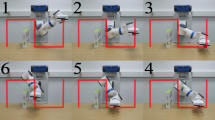Abstract
The off-line global trajectory planning for kinematically redundant manipulators is formulated as an optimization problem whose solution is obtained by applying the Pontryagin’s Maximum Principle. The state space augmentation method is developed to obtain a set of optimal joint trajectories corresponding to a singularity-free Cartesian path which avoids joint limits and conserves joint configuration in cyclic motion. Results of computer simulation conducted on a three-degree-of-freedom planar manipulator are presented and discussed.
Similar content being viewed by others
References
Whitney, D. E.: The mathematics of coordinated control of prostheses and manipulators, J. Dyn. Syst. Meas. Control 94(4) (1972), 303–309.
Klein, C. A. and Huang, C. H.: Review of pseudoinverse control for use with kinematically redundant manipulators, IEEE Trans. Systems Man Cybernet. SMC-13(3) (1983), 245–250.
Yoshikawa, T.: Manipulability of robotic mechanism, Int. J. Robotics Res. 4(2) (1985), 39.
Maciejewski, A. A. and Klein, C. A.: Obstacle avoidance for kinematically redundant manipulators in dynamically varying environments, Int. J. Robotics Res. 4(3) (1985), 109–117.
Kazerounian, K. and Wang, Z.: Global versus local optimization in redundancy resolution of robotic manipulators, Int. J. Robotics Res. 7(5) (1988), 3–12.
Nguyen, C. C., Zhou, Z. L., and Mosier, G. E.: Joint-space adaptive control of a redundant telerobot manipulator, in: Proc. 4th IEEE Int. Symp. on Intelligent Controls, Albany, NY, 1989, pp. 59–65.
Nenchev, D.: Redundancy resolution through local optimization: a review, J. Robotic Systems 6(6) (1989), 769–798.
Nakamura, Y.: Redundancy and Optimization, Addison-Wesley, 1990.
Koivo, A. J. and Arnautovic, S. H.: Dynamic optimum control of redundant manipulators, in: Proc. IEEE Int. Conf. Robotics and Automation, Sacramento, CA, 1991, pp. 466–471.
Luck, C. L. and Lee, S.: Self-motion topology for redundant manipulators with joint limits, in: Proc. IEEE Int. Conf. on Robotics and Automation, Atlanta, 1993, pp. 626–631.
Zhou, Z. L.: Trajectory planning and control of kinematically redundant robotic manipulators, PhD Dissertation, The Catholic University of America, Washington, DC, 1993.
Chan, T. F. and Dubey, R.: A weighted least-norm solution based scheme for avoiding joint limits for redundant joint manipulators, IEEE Trans. Robotics Automat. 11(1995), 286–292.
Pontryagin, L. S.: The Mathematical Theory of Optimal Processes, John Wiley and Sons, 1962.
Kirk, D. E.: Optimal Control Theory, Prentice-Hall, 1970.
Press, W. H.: Numerical Recipes in C: The Art of Scientific Computing, Cambridge Univ. Press, 1988.
Author information
Authors and Affiliations
Rights and permissions
About this article
Cite this article
Zhou, ZL., Nguyen, C.C. Globally Optimal Trajectory Planning for Redundant Manipulators using State Space Augmentation Method. Journal of Intelligent and Robotic Systems 19, 105–117 (1997). https://doi.org/10.1023/A:1007905817998
Issue Date:
DOI: https://doi.org/10.1023/A:1007905817998




